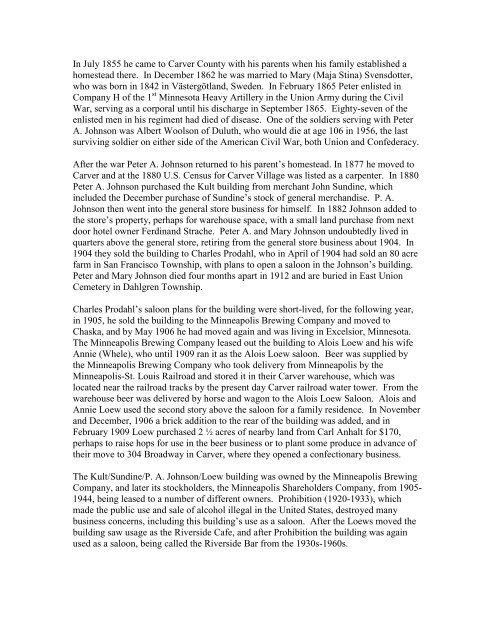Historic Homes and Businesses in Carver - Carver County Historical ...
Historic Homes and Businesses in Carver - Carver County Historical ...
Historic Homes and Businesses in Carver - Carver County Historical ...
You also want an ePaper? Increase the reach of your titles
YUMPU automatically turns print PDFs into web optimized ePapers that Google loves.
In July 1855 he came to <strong>Carver</strong> <strong>County</strong> with his parents when his family established a<br />
homestead there. In December 1862 he was married to Mary (Maja St<strong>in</strong>a) Svensdotter,<br />
who was born <strong>in</strong> 1842 <strong>in</strong> Västergötl<strong>and</strong>, Sweden. In February 1865 Peter enlisted <strong>in</strong><br />
Company H of the 1 st M<strong>in</strong>nesota Heavy Artillery <strong>in</strong> the Union Army dur<strong>in</strong>g the Civil<br />
War, serv<strong>in</strong>g as a corporal until his discharge <strong>in</strong> September 1865. Eighty-seven of the<br />
enlisted men <strong>in</strong> his regiment had died of disease. One of the soldiers serv<strong>in</strong>g with Peter<br />
A. Johnson was Albert Woolson of Duluth, who would die at age 106 <strong>in</strong> 1956, the last<br />
surviv<strong>in</strong>g soldier on either side of the American Civil War, both Union <strong>and</strong> Confederacy.<br />
After the war Peter A. Johnson returned to his parent‟s homestead. In 1877 he moved to<br />
<strong>Carver</strong> <strong>and</strong> at the 1880 U.S. Census for <strong>Carver</strong> Village was listed as a carpenter. In 1880<br />
Peter A. Johnson purchased the Kult build<strong>in</strong>g from merchant John Sund<strong>in</strong>e, which<br />
<strong>in</strong>cluded the December purchase of Sund<strong>in</strong>e‟s stock of general merch<strong>and</strong>ise. P. A.<br />
Johnson then went <strong>in</strong>to the general store bus<strong>in</strong>ess for himself. In 1882 Johnson added to<br />
the store‟s property, perhaps for warehouse space, with a small l<strong>and</strong> purchase from next<br />
door hotel owner Ferd<strong>in</strong><strong>and</strong> Strache. Peter A. <strong>and</strong> Mary Johnson undoubtedly lived <strong>in</strong><br />
quarters above the general store, retir<strong>in</strong>g from the general store bus<strong>in</strong>ess about 1904. In<br />
1904 they sold the build<strong>in</strong>g to Charles Prodahl, who <strong>in</strong> April of 1904 had sold an 80 acre<br />
farm <strong>in</strong> San Francisco Township, with plans to open a saloon <strong>in</strong> the Johnson‟s build<strong>in</strong>g.<br />
Peter <strong>and</strong> Mary Johnson died four months apart <strong>in</strong> 1912 <strong>and</strong> are buried <strong>in</strong> East Union<br />
Cemetery <strong>in</strong> Dahlgren Township.<br />
Charles Prodahl‟s saloon plans for the build<strong>in</strong>g were short-lived, for the follow<strong>in</strong>g year,<br />
<strong>in</strong> 1905, he sold the build<strong>in</strong>g to the M<strong>in</strong>neapolis Brew<strong>in</strong>g Company <strong>and</strong> moved to<br />
Chaska, <strong>and</strong> by May 1906 he had moved aga<strong>in</strong> <strong>and</strong> was liv<strong>in</strong>g <strong>in</strong> Excelsior, M<strong>in</strong>nesota.<br />
The M<strong>in</strong>neapolis Brew<strong>in</strong>g Company leased out the build<strong>in</strong>g to Alois Loew <strong>and</strong> his wife<br />
Annie (Whele), who until 1909 ran it as the Alois Loew saloon. Beer was supplied by<br />
the M<strong>in</strong>neapolis Brew<strong>in</strong>g Company who took delivery from M<strong>in</strong>neapolis by the<br />
M<strong>in</strong>neapolis-St. Louis Railroad <strong>and</strong> stored it <strong>in</strong> their <strong>Carver</strong> warehouse, which was<br />
located near the railroad tracks by the present day <strong>Carver</strong> railroad water tower. From the<br />
warehouse beer was delivered by horse <strong>and</strong> wagon to the Alois Loew Saloon. Alois <strong>and</strong><br />
Annie Loew used the second story above the saloon for a family residence. In November<br />
<strong>and</strong> December, 1906 a brick addition to the rear of the build<strong>in</strong>g was added, <strong>and</strong> <strong>in</strong><br />
February 1909 Loew purchased 2 ½ acres of nearby l<strong>and</strong> from Carl Anhalt for $170,<br />
perhaps to raise hops for use <strong>in</strong> the beer bus<strong>in</strong>ess or to plant some produce <strong>in</strong> advance of<br />
their move to 304 Broadway <strong>in</strong> <strong>Carver</strong>, where they opened a confectionary bus<strong>in</strong>ess.<br />
The Kult/Sund<strong>in</strong>e/P. A. Johnson/Loew build<strong>in</strong>g was owned by the M<strong>in</strong>neapolis Brew<strong>in</strong>g<br />
Company, <strong>and</strong> later its stockholders, the M<strong>in</strong>neapolis Shareholders Company, from 1905-<br />
1944, be<strong>in</strong>g leased to a number of different owners. Prohibition (1920-1933), which<br />
made the public use <strong>and</strong> sale of alcohol illegal <strong>in</strong> the United States, destroyed many<br />
bus<strong>in</strong>ess concerns, <strong>in</strong>clud<strong>in</strong>g this build<strong>in</strong>g‟s use as a saloon. After the Loews moved the<br />
build<strong>in</strong>g saw usage as the Riverside Cafe, <strong>and</strong> after Prohibition the build<strong>in</strong>g was aga<strong>in</strong><br />
used as a saloon, be<strong>in</strong>g called the Riverside Bar from the 1930s-1960s.


